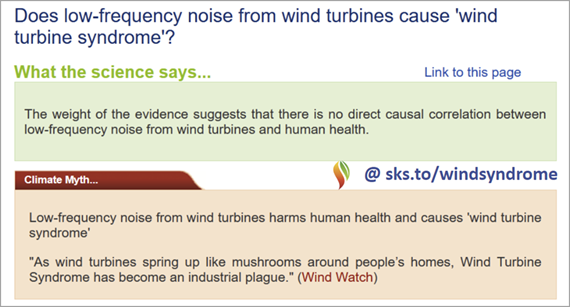Sabin 33 #17 - Does low-frequency noise from wind turbines cause 'wind turbine syndrome'?
Posted on 25 February 2025 by BaerbelW
On November 1, 2024 we announced the publication of 33 rebuttals based on the report "Rebutting 33 False Claims About Solar, Wind, and Electric Vehicles" written by Matthew Eisenson, Jacob Elkin, Andy Fitch, Matthew Ard, Kaya Sittinger & Samuel Lavine and published by the Sabin Center for Climate Change Law at Columbia Law School in 2024. Below is the blog post version of rebuttal #17 based on Sabin's report.
The weight of the evidence suggests that there is no direct causal correlation between low-frequency noise from wind turbines and human health1 (also Marshall et al. 2023, Radun et al. 2022, van Kamp & van den Berg 2021, Schmidt et al. 2014, Dumbrille et al. 2021). Individual cases of sleep disturbance among people living in proximity to new wind turbines are more likely the result of annoyance about the presence of those turbines rather than inaudible noise emanating from them2.
One historical study looked at complaints filed in relation to 51 Australian wind farms from 1993 to 2012. Prior to 2009, complaints related to health and noise were rare, despite the fact that many small and large wind farms were already in operation. However, following the coining of the phrase "wind turbine syndrome" in a self-published book that year, there was a dramatic spike in complaints (Crichton et al. 2014).
Footnotes:
[1] Wind Energy Technologies Office, Frequently Asked Questions about Wind Energy, Office of Energy Efficiency and Renewable Energy, U.S. Department of Energy (last visited March 25, 2024); NHMRC Statement: Evidence on Wind Farms and Human Health, National Health and Medical Research Council (NHMRC), Australian Government, 1 (2015); Tracy Merlin et al., Systematic review of the human health effects of wind farms, National Health and Medical Research Council, 2013; but see Richard R. James, Wind Turbine Infra and Low-Frequency Sound: Warning Signs That Were Not Heard, 32 Bulletin of Science, Technology, and Society, 2012 (analyzing “historical evidence about what was known regarding infra and low-frequency sound from wind turbines and other noise sources during the period from the 1970s through the end of the 1990s” to conclude that wind energy may be causing adverse impacts to some people living near wind turbines); Anne Dumbrille et al., Wind turbines and adverse health effects: Applying Bradford Hill’s criteria for causation, 6 Environmental Disease 109, 2021, at 65, (concluding that, while “[i]ncontrovertible proof of causation has tended to be an elusive goal,” when a lower standard of causality is applied, “recurring sleep disturbance, anxiety, and stress” can be attributed to industrial wind turbines).
[2] van Kamp & van den Berg (2021). A front-page newspaper article from 2015 that attempted to infer a direct causal relationship between turbine-related infrasound and human health impacts based on the findings of a non-peer-reviewed study was widely criticized. See Jacqui Hoepner & Will J Grant, Wind turbine studies: how to sort the good, the bad, and the ugly, Conversation, Jan. 21, 2015; Ketan Joshi, Windfarm weirdness syndrome is real. Just look at our national ‘debate’, Guardian, Feb. 23, 2015
Skeptical Science sincerely appreciates Sabin Center's generosity in collaborating with us to make this information available as widely as possible.![]()































 Arguments
Arguments































I invented a method that has made all wind turbines silent before Covid, I have not heard a climate skeptic complaining of lound wind turbines for some years now. The money I got for my work was spent on shares whose dividends go to XR.
RedRoseAndy @1 just made a claim about wind turbines completely lacking in credibility, detail, methodology, or evidence. He seems to have a record of implausible claims, crank science, and of presenting old ideas as if they are his own. Please refer:
www.buzzfeed.com/redroseandy
www.kadir-buxton.com/climate-crisis-issues
I suppose I shouldn't really give him free advertising, but maybe, just maybe theres a useful idea buried in there somewhere.
Quite a few studies [snip]
provide much better context of wind turbine noise than the SK rebuttal article.
Much is made in the article of A/C's, refrigerators, etc producing higher noise levels, Two key points are omitted.
A/c's and refrigerators operate at only a fraction of the time of windturbines ie 24/7/365
Its both the decibel level and frequency that matters, not just the decibel level.
www.nature.com/articles/s41598-021-97107-8
www.sciencedirect.com/science/article/pii/S1364032122006852
[BL] This is growing tiresome. You have not given any context to what is contained in the links you provide.
The Comments Policy is clear on this:
I am adding this study on infrasound.
[snip]
There is considerable debate on the subject. Most all the studies that I found on the subject appeared to have an agenda in the study either claiming zero harm or claiming significant harm, thus warranting dismissal due to heavy bias. This study seemed to be more honest in the assessment.
www.sciencedirect.com/science/article/pii/S2210670722006126
[BL] Again, you need to explain what people should look for in your link, and why it is relevant.
If you continue in this pattern, the next stage will be deletion of entire comments.
Another way of looking at the wind turbine noise issue.
Low frequency noise from wind turbines needs to be put in perspective. In my view its virtually a complete non issue as follows. The worst case is turbines emit 60 - 80dbs of noise standing about 2 metres from the turbines. This is like playing music moderately loud. It includes low middle and high frequencies. I'm not sure about infrasonic frequencies (sub audible at 1 - 20 hz) but lets assume its quite high at 100 hz. But virtually nobody stands next to a turbine for long lengths of time unless its for maintenance and the turbine would likely be switched off anyway.
Less than 1% of the population live near turbines and the farm houses are typically at least 300 metres away, where noise levels drop to about 35 - 45 hz the sound level of a quiet domestic fridge or quiet conversation. Low frequencies carry a bit further than higher frequencies but not enough to be an issue. Its all clearly a non issue.
Compare this with typical automobiles. They produce 50 - 75 dbs noise in urban streets when sitting in the car, and they produce close to that level of sound when standing on the footpath. This is similar to standing next to a wind turbine. It includes middle and low frequency noise. Many automobiles produce infrasonics which can be up to 100 dbs which is loud (although they are inaudible pressure waves like you get from a big sub woofer). Houses are often about 10 - 30 metres from a road so the noise level would be about 45 - 55 dbs which is moderate conversation levels and can be annoying.
Billions of people use cars and live about 20 metres from a road. This is a much greater population exposure to noise, and to higher levels of noise than wind turbines but the complainers about turbines ignore this. If they were really worried about noise and its impacts on health and our nerves they would promote EV's which are near whisper quiet. Wind turbine noise levels:
windexchange.energy.gov/projects/sound#:~:text=On%20average%2C%20land%2Dbased%2C,to%20a%20home%20or%20building).